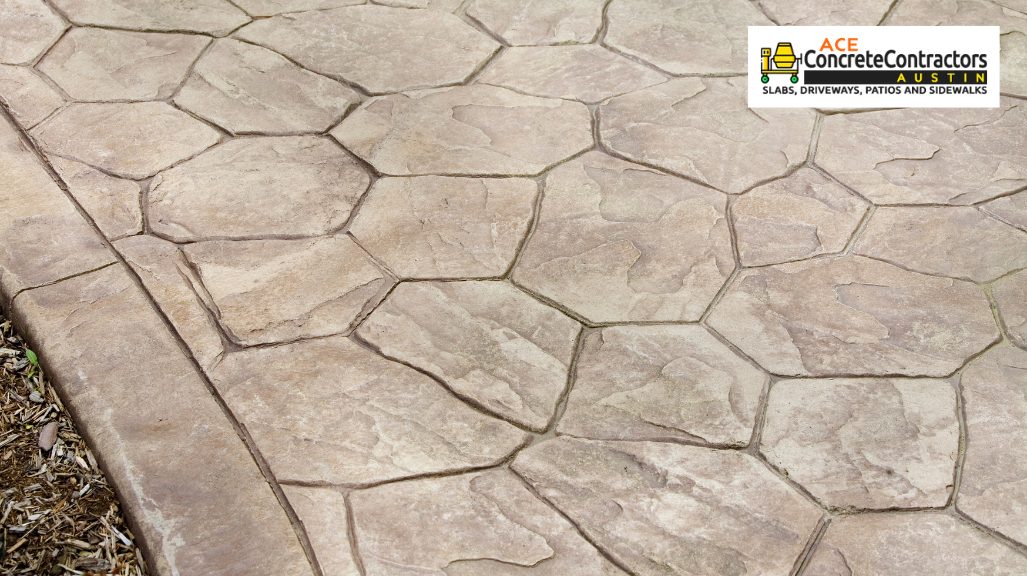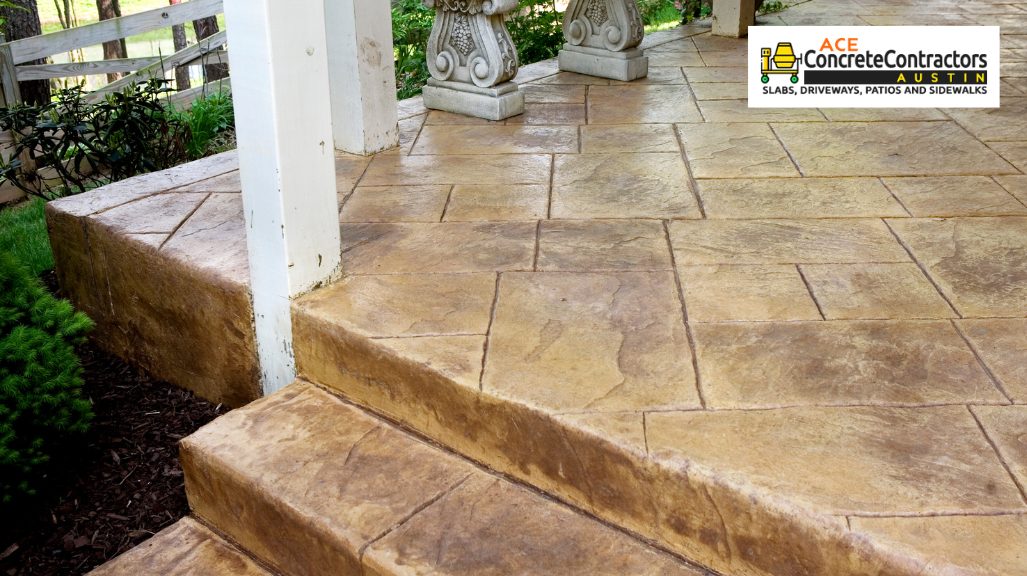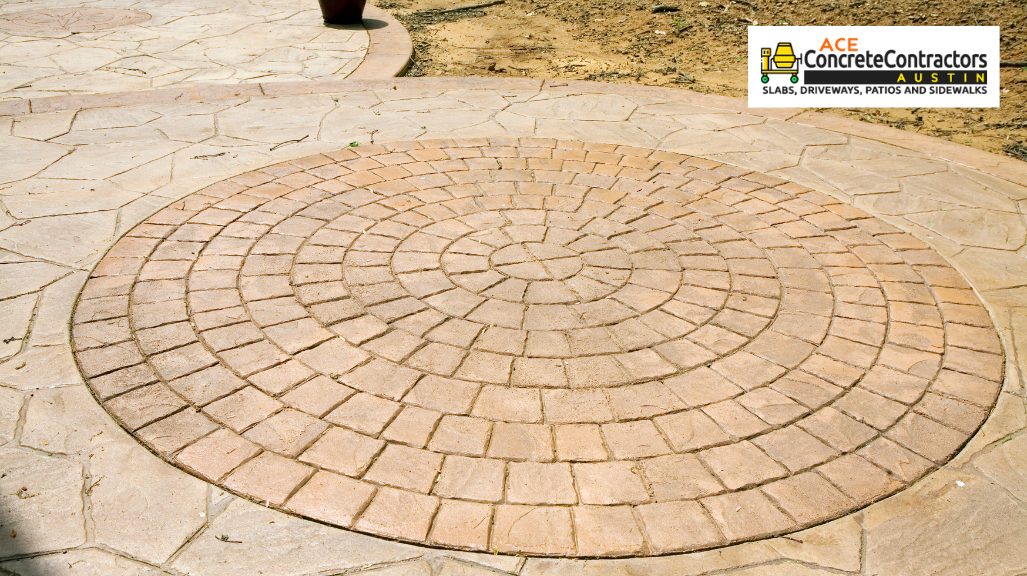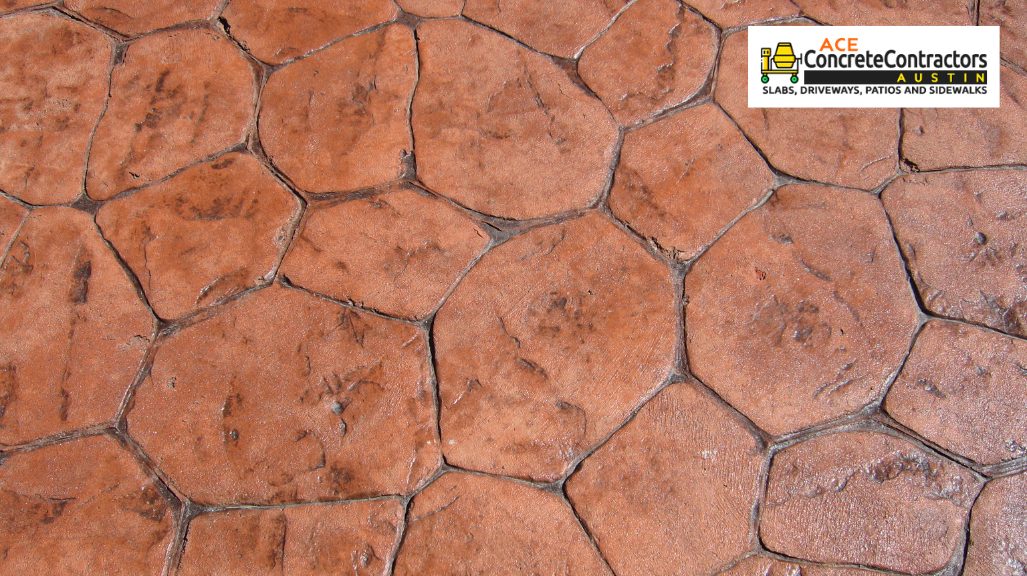
Table of Contents
A stamped concrete patio offers a cost-effective, durable alternative to high-end materials like stone, brick, or wood. Ace Concrete Contractors Austin specializes in creating stunning stamped concrete designs. You can achieve various aesthetic effects with different colors, patterns, and textures, making it versatile for any design vision. Installation involves preparing the site, pouring and smoothing concrete, and stamping patterns before it sets. With minimal maintenance requirements and excellent weather resistance, stamped concrete is both practical and stylish. If you explore further, you’ll discover the many design options and benefits that make stamped concrete patios attractive for transforming outdoor spaces.
Key Takeaways
- Stamped concrete patios mimic the appearance of materials like stone, brick, or wood.
- They offer a cost-effective and durable alternative to natural materials.
- Stamped concrete patios require minimal maintenance compared to traditional paving options.
- The quick installation process allows for prompt enhancement of outdoor spaces.
- Various colors, patterns, and textures are available for customization.
Definition of Stamped Concrete

Stamped concrete, often called textured or imprinted concrete, is a design technique used to replicate the appearance of stone, brick, or wood. This method leverages concrete’s versatility to offer a cost-effective, durable, and visually appealing alternative to natural materials. You might appreciate the stamped benefits, such as its ability to withstand harsh weather conditions while requiring minimal maintenance compared to traditional paving options. Knowing how to fix cracks in a concrete patio is essential for maintaining the durability of your outdoor space.
In decorative applications, stamped concrete allows for a wide range of aesthetic variations. You can choose from various colors, patterns, and textures to create a custom look that seamlessly integrates with your outdoor environment. Whether aiming for a rustic, natural feel or a sleek, modern design, stamped concrete can meet your needs.
Moreover, stamped concrete installation is relatively quick, making it an efficient option for those who want to enhance their space quickly. With its practical and aesthetic advantages, stamped concrete is a smart choice for any patio project.
Installation Process
When you’re ready to install a stamped concrete patio, several vital steps are involved to confirm a high-quality finish. First, you must prepare the site by excavating the area and installing a stable base, typically compacted gravel. This foundational work guarantees the patio’s durability and longevity. Next, formwork is set up to outline the patio’s shape. Once your forms are in place, concrete is poured and spread evenly.
Smoothing techniques are used here. Using a bull float, you’ll smooth the surface to eliminate imperfections. After achieving a level surface, the concrete must be set just enough to hold the imprint from the stamping tools. Stamping is the critical phase where you press patterns into the surface to mimic natural materials like stone or brick. Timing is vital; the concrete should be firm enough to hold the stamp but still pliable.
Design Options

When considering design options for your stamped concrete patio, you can select from various patterns and textures to mimic natural stone, brick, or even wood. You also have the flexibility to customize colors to match your landscape or home exterior. Explore border and accent ideas to add a distinctive touch to your patio design.
Pattern and Texture Choices
Understanding the diverse pattern and texture choices available for a stamped concrete patio is essential to genuinely elevating the aesthetic appeal of your outdoor space. You can customize your patio with many style variations and texture combinations to perfectly match your design vision and create a cohesive outdoor environment. Pattern choices range from classic brick and cobblestone to intricate slate and tile designs. Each pattern provides a unique visual appeal and can complement different architectural styles.
For instance, a brick pattern might suit a traditional home, while a slate pattern could enhance a modern design. Texture combinations are equally important in achieving the desired look and feel. Smooth textures offer a sleek, refined appearance, while rougher textures can mimic the natural feel of stone or wood. Combining textures can create a more dynamic and visually exciting surface. For example, pairing a smooth border with a textured center can add depth and dimension to your patio.
Color Customization Options
Color customization options are pivotal in bringing your stamped concrete patio to life, adding depth and personality to your outdoor space. The right color palette guarantees your patio complements your home and integrates seamlessly with the surrounding environment. You can achieve this through color blending and tint application, which provide a rich, multi-dimensional look.
Color blending involves mixing multiple hues to create a natural, variegated appearance that mimics the look of stone, brick, or wood. This method adds complexity and realism to stamped concrete, which is indistinguishable from traditional materials. Tint application, on the other hand, allows for precise control of color intensity and shade. This technique is ideal for achieving uniformity and vibrancy, guaranteeing your patio stands out while harmonizing with your design scheme.
Choosing suitable color customization options enhances the aesthetic appeal of your patio and creates a sense of cohesion and belonging in your outdoor space. Whether you prefer subtle earth tones or bold, eye-catching colors, these techniques allow you to tailor your patio to your personal taste and design vision.
Border and Accent Ideas
Enhancing your stamped concrete patio isn’t just about selecting the right colors; incorporating borders and accents can elevate your design to a new level. Borders provide a defined edge that can frame your patio, adding both visual interest and a sense of completeness. Popular border styles include contrasting color bands, brick patterns, or even natural stone looks. These styles enhance the aesthetic appeal and create a cohesive flow that ties the entire patio together.
Accent features allow you to introduce unique elements that can serve as focal points. You might consider incorporating medallions, geometric shapes, or custom designs that reflect your style. Accent features can break up large areas of stamped concrete, making the space more dynamic and engaging.
When selecting border styles and accent features, make sure they complement your patio’s overall design and color scheme. Consistency in design elements fosters a sense of unity and belonging, making your outdoor space a functional area and a harmonious extension of your home. This attention to detail will make your stamped concrete patio stand out in outdoor living.
Explore the Next Blog: What is a Concrete Patio?
Cost Comparison

When comparing costs, stamped concrete patios generally have lower material and labor costs than natural stone or pavers. However, consider the maintenance expenses, as stamped concrete may require periodic sealing to maintain its appearance and durability. Evaluating these factors will help you decide on your patio project.
Material and Labor Costs
How much should you expect to spend on a stamped concrete patio? The costs can vary significantly based on material sourcing and labor rates. The materials cost an average of $8 to $12 per square foot, including the concrete mix, colorants, and stamping tools. The price variability often stems from your choices in design and color. High-quality materials can elevate your patio’s aesthetic appeal and durability, but they come at a higher price.
Labor rates will also impact your budget. Expect to pay between $10 and $15 per square foot for professional labor. These rates account for the expertise required to prepare the site, pour the concrete, and precisely apply the stamps. Labor costs can fluctuate based on regional differences and the complexity of the design you choose. Intricate patterns and custom designs will naturally require more time and skill, adding to the overall cost.
Maintenance Expense Differences
Besides the initial investment in materials and labor, the long-term costs of maintaining a stamped concrete patio should also be considered. Maintenance expenses vary markedly depending on your chosen cleaning techniques and sealing products.
Stamped concrete patios require regular cleaning to maintain aesthetic appeal and structural integrity. Basic cleaning techniques involve sweeping and washing the surface with mild detergent and water, which can be done frequently at minimal cost. For more thorough cleaning, you might need a pressure washer, which can be a more considerable but occasional expense.
Sealing products protect your stamped concrete patio from wear and tear, weather elements, and stains. High-quality sealers, applied every 2-3 years, can cost between $0.15 to $0.25 per square foot. While this may seem modest, neglecting this step can lead to costly repairs.
Compared to other materials like natural stone or pavers, maintaining a stamped concrete patio is relatively low-cost. However, consistent upkeep using appropriate cleaning techniques and sealing products guarantees longevity and preserves the patio’s visual appeal, making it a worthwhile investment for those seeking beauty and durability.
Durability and Maintenance

Stamped concrete patios are celebrated and hardy. They are robust not only for their aesthetic appeal but also for their robust durability and relatively low maintenance requirements. These patios stand up exceptionally well to various weather conditions, showcasing impressive weather resistance. Whether exposed to scorching sun, heavy rain, or freezing temperatures, stamped concrete maintains its integrity and visual appeal.
Stamped concrete requires minimal effort for long-term care. Regular sweeping and occasional washing with a garden hose will keep your patio looking pristine. It’s important to reseal your stamped concrete patio every 2-3 years to protect it from stains, moisture, and wear. A high-quality sealant enhances the color and luster and adds an extra layer of protection against harsh elements. Cracks and surface damage are rare but can occur due to heavy loads or extreme temperature fluctuations. Fortunately, these issues are typically minor and can be easily repaired without compromising your patio’s overall look and functionality.
Pros and Cons
When evaluating the pros and cons of stamped concrete patios, you’ll find that they frequently offer a compelling mix of design versatility and cost-effectiveness. One significant advantage is their ability to mimic high-end materials like stone or brick, providing a luxurious look without the hefty price tag. Additionally, stamped concrete offers a wide range of color and pattern options, allowing you to customize your patio to fit any aesthetic preference.
However, the weather impact on stamped concrete should be considered. The material may expand and contract in regions with extreme seasonal changes, leading to potential cracks. Proper installation and regular maintenance can mitigate this issue, but you need to keep it in mind. Another con is that stamped concrete surfaces can become slippery when wet, posing a safety risk.
On the plus side, stamped concrete has relatively low maintenance compared to other patio materials. It’s resistant to weeds and doesn’t require frequent sealing. However, if not sealed properly, the color might fade over time. Weighing these factors can help you decide whether a stamped concrete patio is appropriate for your lifestyle and environmental conditions, ensuring a cohesive and practical outdoor space.
Popular Patterns
While weighing the advantages and challenges of stamped concrete patios, the array of available patterns often stands out as a significant highlight. These patterns can transform your outdoor space into a stylish, inviting area that reflects modern trends and your personal taste. The most popular patterns include slate, brick, and cobblestone, each providing a unique texture and aesthetic appeal.
Whether you’re after rustic charm or a sleek, contemporary look, there’s a pattern to match your vision. Slate patterns mimic real slate’s natural, rugged texture, offering a sophisticated yet durable finish. Brick patterns, however, evoke a classic, timeless appeal that suits traditional and modern homes alike.
Cobblestone patterns are perfect for creating an old-world, European ambiance and adding character and charm. When selecting a pattern, consider seasonal factors. For instance, darker patterns may absorb more heat in the summer, making it less comfortable to walk barefoot. Conversely, lighter patterns can reflect sunlight, keeping surfaces cooler.
Color Choices

Color choices can dramatically influence your stamped concrete patio’s overall look and feel. Selecting the right hues is vital for creating an atmosphere that aligns with your desired aesthetic and the psychological impact you wish to achieve.
Colors like earthy browns and muted grays evoke a sense of stability and tranquility, often resonating with those seeking a natural, cohesive outdoor space. Conversely, brighter colors like terracotta or sandstone can infuse your patio with warmth and energy, enhancing social gatherings.
Understanding color psychology can help you make choices that look good and feel right. For instance, blue-toned concrete can create a calming, serene environment, perfect for relaxation. In contrast, vibrant reds or oranges can stimulate activity and conversation, ideal for lively get-togethers.
Seasonal trends also play an important role in color selection. During spring and summer, lighter and more vibrant colors are popular, reflecting the blooming environment and longer daylight hours.
Deeper, richer tones are favored in autumn and winter, aligning with the season’s cozy and warm ambiance. By considering both color psychology and seasonal trends, you can design a patio that feels inviting year-round.
Enhancing Your Patio
Selecting the perfect colors for your stamped concrete patio sets the stage for a visually appealing space, but enhancing your patio goes beyond just hues. Consider the elements that will complement your design to create a truly inviting and functional outdoor area.
Start with patio furniture that balances comfort and style. High-quality, weather-resistant materials guarantee longevity and maintain aesthetic appeal. Opt for seating arrangements that encourage conversation and relaxation. Outdoor lighting is another critical aspect. Well-placed lighting can transform your patio into an enchanting evening retreat. Use a mix of ambient, task, and accent lighting to highlight architectural features and provide adequate illumination.
Integrate natural elements like plants and water features. Greenery adds a rejuvenating touch, creating a seamless shift between the built environment and nature. Water features like fountains or small ponds introduce a soothing auditory element.
Consider these essentials to enhance your patio:
- Patio furniture for comfort and style
- Outdoor lighting for ambiance and functionality
- Natural elements like plants and water features
- Shade structures such as pergolas or umbrellas
- Decorative accessories like rugs and cushions
Frequently Asked Questions
Is Stamped Concrete Slippery When Wet?
Yes, stamped concrete can be slippery when wet. However, with proper stamped concrete maintenance and selecting stamped concrete textures designed for slip resistance, you can guarantee a safer and more durable surface for your patio.
Can Stamped Concrete Be Repaired if Cracked?
Just like repairing the seams of a well-loved book, you can fix cracked stamped concrete. Regular stamped concrete maintenance guarantees longevity, preserving the design’s integrity and keeping your space unified and inviting.
How Long Does Stamped Concrete Take to Dry?
The drying process takes about 24-48 hours, but the curing time for stamped concrete typically lasts 28 days. This guarantees durability and prevents future issues, making it essential for a long-lasting design.
Does Stamped Concrete Fade Over Time?
Yes, stamped concrete can fade over time. To guarantee color retention, regularly apply a quality sealer and follow maintenance tips like cleaning and avoiding harsh chemicals. This will keep your patio looking vibrant and well-maintained.
Are There Eco-Friendly Options for Stamped Concrete?
You want a beautiful patio without harming the planet. Yes, there are eco-friendly options for stamped concrete. Using sustainable materials will reduce environmental impact while achieving a stunning, durable design that fits your values.
Conclusion
You won’t believe how transformative a stamped concrete patio can be! With countless design options, colors, and patterns, you’ll turn your outdoor space into a jaw-dropping masterpiece. It’s a cost-effective, durable choice that requires minimal maintenance. Sure, it has some drawbacks, but the benefits far outweigh them. Imagine your friends’ faces when they see your stunning, customized patio. Don’t settle for ordinary—go for extraordinary with stamped concrete. Your dream backyard is just a pour away!
